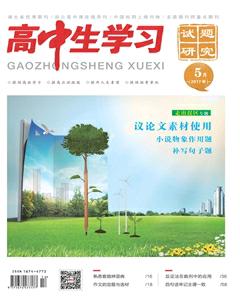时态题解答四法
籍万杰
汉语中的动词没有时态,而英语中动词的时态多达十六种,常用的也达八种之多。这种语言差异造成同学们很难养成注意动词时态的习惯,而动词时态是高考语法填空和短文改错的必考考点。同学们利用下面的四种方法,便能快速、正确地解答时态题。
[找标法]
如果考查时态的句子中有标志性的时间状语,则往往可以据此使用相应的时态。
例1 In recent years, stress _______ (regard) as a cause of a whole range of medical problems, from high blood pressure to mental illness.
解析 has been regarded。该句缺谓语动词,空格中的regard应使用谓语动词形式。根据时间状语In recent years可知应使用现在完成时;根据句意可知此处表示被动;再根据与主语stress的一致关系可知,应填has been regarded。
例2 Leaving the less important things until tomorrow 63 (be) often acceptable.
解析 分析句子结构可知,该句的主语是动名词短语Leaving the less important things until tomorrow,此处be应使用谓语动词形式,并且是第三人称单数,再结合本句中的often可知,应该使用一般现在時,故填is。
例3 —Excuse me, which movie are you waiting for?
—The new Star Wars. We _______ (wait) here for more than two hours.
解析 have been waiting。“for+时间段”与完成时连用,根据语境可知,说话的时候仍然在等,因此用现在完成进行时,故填have been waiting。
例4 More efforts, as reported, _______ (make) in the years ahead to accelerate the supply-side structural reform.
解析 will be made。in the years ahead意思是“在未来的几年”,是一般将来时的标志,而且more efforts与make构成被动关系,所以应使用一般将来时的被动形式。
例5 Silk _______ (become) one of the primary goods traded along the Silk Road by about 100 BC.
解析 had become。时间标志词是“by+过去时间”,意思是到过去的某个时间为止,表示的是“过去的过去”,谓语动词应使用过去完成时,故填had become。
点拨 要熟记常用时态所对应的时间状语。
1. 一般现在时:often,always,sometimes,usually,seldom,now,every day等。
2. 一般过去时:then,yesterday,last week,after that,ago等。
3. 现在进行时:now,right now,at present,at this moment,these days。
4. 过去进行时:at that time,at this time yesterday,at eight oclock yesterday,from one oclock to three oclock yesterday,between one oclock and three oclock yesterday等。
5. 现在完成时:recently,lately,up to/till now,so far,in the past/last few months/years ...,“for+一段时间”,“since+一段时间”等。
6. 过去完成时:before,by the end of last month/years ... 等。
7. 一般将来时:tomorrow,next week/month ... ,in an hour等。
8. 过去将来时:the following month,the next week。
[呼应法]
如果是主从复合句,可根据主从句时态呼应的原则使用正确的时态。
例6 Just as I got to the school gate, I realized I _______ (leave) my book in the cafe.
解析 had left。从句时态要与主句保持一致,“落下”这个动作发生在过去,且发生在“意识到”这个动作之前,表示“过去的过去”,故应使用过去完成时。
例7 As you go through this book, you _______ (find) that each of the millions of people who lived through World War II had a different experience.
解析 这是一个含有as引导的时间状语从句的主从复合句。从句中使用一般现在时表示将来,根据“主将从现”的时态使用原则,主句中应该使用一般将来时。
例8 Unless extra money _______ (find), the theatre will close.
解析 is found。句意为:除非找到额外的钱,否则这家剧院得关门。这是一个含有unless引导的让步状语从句的复合句,主句使用一般将来时,根据“主将从现”的原则,从句应使用一般现在时,且此处表示被动。
点拨 在根据主从句时态呼应原则解题时,要把握以下两点:
1. 在含有时间、条件等状语从句的主从复合句中,应贯彻“主将从现”的时态搭配原则。
2. 在含有宾语从句的主从复合句中,同学们应熟知以下规则:主句动词为现在时,则从句动词可根据需要使用任何时态;主句动词为过去时,则从句动词须用合适的过去时态(表示客观真理时用一般现在时)。
[搭配法]
如果句子构成某种时态的固定搭配或特殊句式,则根据规则使用相应的时态。
例9 Jack _______ (work) in the lab when the power cut occurred.
解析 was working。此句含有be doing ... when ...固定句型,意思是“某人正在做……时,突然……”。主句使用过去进行时,从句使用一般过去时。
例10 Why didnt you tell me about your trouble last week? If you _______ (tell) me, I could have helped.
解析 空格處的句子是虚拟语气,表示对过去的虚拟,if从句中用过去完成时,故填had told。
例11 Close the door of fear behind you, and you _______ (see) the door of faith open before you.
解析 will see。句意:关上你身后的惧怕之门,你就会看到信心之门在你面前敞开着。“祈使句+and/or+简单句”是并列句的一种固定句式,and/or后的简单句通常用将来时或用情态动词表示将来。
点拨 高考测试的热点句型有:
1. sb. was doing (about to do) ... when ... (一般过去时);sb. had just done ... when ... (一般过去时)
2. no sooner ... (过去完成时)than ... (一般过去时);hardly ... (过去完成时)when ... (一般过去时)
3. It is/was the first/second ... time ... (现在/过去完成时)
4. It is/has been some time since sb. did ...
5. It will be some time before sb. do/does ...
6. If sb. dont/doesnt do sth., nor will sb.
7. sb. did ... before sb. did/could do ...
[语境法]
如果找不到时间标志,也不是固定搭配或主从复合句,同学们应根据具体语境使用合适的时态。
例12 So it was a great honour to be invited backstage at the not-for-profit Panda Base ... I 62 , (allow) to get up close to these cute animals at the 600-acre centre.
解析 was allowed。该句中没有谓语动词,空格处应填谓语动词。allow通常用allow sb. to do sth.这一搭配,根据句型和句意可知,此处应为be allowed to do。由前一句中的was可知,此处应使用一般过去时。
例13 He must have sensed that I _______ (look) at him. He suddenly glanced at me and said quietly, “Why are you staring at me like that?”
解析 was looking。句意:他当时肯定是感觉到我在看他。他突然瞥了我一眼然后轻声问道:“你为什么要那样盯着我看?”根据句意可知此处表示当时“我正在看他”,再根据前面的must have sensed(表示对过去的推测)和后面的glanced at可知应该使用过去进行时。
点拨 近年来高考试题对时态考查的要求越来越高,大部分试题趋向情境化。我们的对策是:捕捉信息,理解情境,综合运用,灵活答题。

